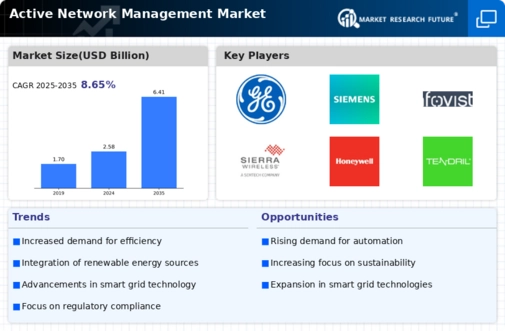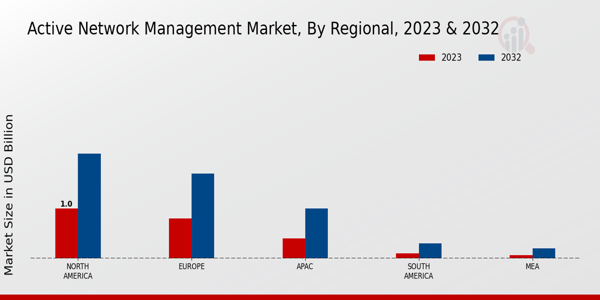Market Growth Projections
The Global Active Network Management Market Industry is poised for substantial growth, with projections indicating a market size of 2.58 USD Billion in 2024 and an anticipated increase to 6.41 USD Billion by 2035. This growth trajectory reflects a compound annual growth rate of 8.63% from 2025 to 2035, driven by various factors such as technological advancements, regulatory support, and the integration of renewable energy sources. The market dynamics suggest a robust demand for active network management solutions, which are essential for optimizing energy distribution and enhancing grid reliability in an increasingly complex energy landscape.
Growing Demand for Energy Efficiency
The Global Active Network Management Market Industry experiences a growing demand for energy efficiency as organizations seek to reduce operational costs and environmental impact. This trend is driven by regulatory frameworks that encourage sustainable practices. For instance, governments worldwide are implementing policies that promote the integration of renewable energy sources into existing grids. As a result, the market is projected to reach 2.58 USD Billion in 2024, reflecting a significant shift towards technologies that enhance energy management and optimize resource allocation. The emphasis on energy efficiency is likely to propel the adoption of active network management solutions.
Integration of Renewable Energy Sources
The integration of renewable energy sources into the grid is a pivotal driver for the Global Active Network Management Market Industry. As countries strive to meet their renewable energy targets, the need for advanced management systems becomes apparent. These systems facilitate the seamless incorporation of solar, wind, and other renewable sources, thereby enhancing grid stability and reliability. The market is expected to grow significantly, with projections indicating a rise to 6.41 USD Billion by 2035. This growth underscores the importance of active network management in accommodating fluctuating energy supplies and ensuring a balanced energy mix.
Regulatory Support and Policy Frameworks
Regulatory support and policy frameworks play a crucial role in shaping the Global Active Network Management Market Industry. Governments are increasingly recognizing the need for robust energy management systems to achieve sustainability goals. Incentives, subsidies, and mandates for renewable energy adoption are fostering an environment conducive to the growth of active network management solutions. This supportive regulatory landscape is likely to accelerate market expansion, as utilities and energy providers invest in technologies that comply with evolving regulations. The alignment of policy initiatives with market needs suggests a promising future for active network management.
Rising Consumer Awareness and Engagement
Rising consumer awareness and engagement regarding energy consumption are driving the Global Active Network Management Market Industry. As individuals become more conscious of their energy usage and its environmental implications, there is a growing demand for solutions that provide transparency and control over energy consumption. This trend is prompting utilities to adopt active network management systems that empower consumers with real-time data and insights. Enhanced consumer engagement not only fosters energy conservation but also supports the integration of distributed energy resources. This shift in consumer behavior is likely to contribute to the overall growth of the market.
Technological Advancements in Smart Grids
Technological advancements in smart grid technologies are reshaping the Global Active Network Management Market Industry. Innovations such as real-time data analytics, IoT integration, and advanced metering infrastructure enable utilities to monitor and manage energy flows more effectively. These technologies not only enhance operational efficiency but also improve customer engagement through better energy usage insights. The anticipated compound annual growth rate of 8.63% from 2025 to 2035 indicates a robust market trajectory, driven by the increasing deployment of smart grid solutions that facilitate active network management and optimize energy distribution.













